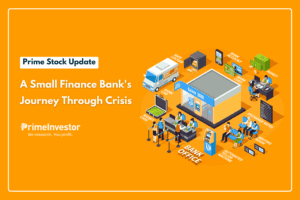Not so long ago, if debt investors in India wanted to get a 7% plus return, they had to go to post office schemes with (poor service and) a long lock-in period like the PPF or GOI Floating Rate Savings Bonds with a 7-year lock-in period. These options, apart from the difficulty of accessing them, required investors to sacrifice liquidity for returns.
But RBI’s recent off-cycle rate hike has put a 7% yield well within reach for debt mutual fund investors even without such lock-ins. In this call, we highlight a debt mutual category and specific funds within it, that can get you close to a 7% yield through the open-ended format, for a 5-year holding period.

Why enter now?
Our earlier article on the interest rate upcycle in India highlighted that market yields had been climbing even before RBI began its current cycle of pegging up interest rates.
But RBI’s sudden off-cycle rate hike last week, has added a new urgency and ferocity to the rise in market yields. The table below shows just how much yields on g-secs have moved just in the last week to 10 days. When bond yields get going, it is the benchmark 10-year g-sec that hogs most of the market attention. Sharp moves in g-secs of lower maturity tend to flow under the radar. This has been happening recently too, with the sharp up moves in the 3 year and 5-year g-sec going largely unnoticed.
With the 5-year g-sec seeing its yields move up past 7.2%, we think this is a good time for investors in debt mutual funds to lock into target maturity funds that invest in g-secs and SDLs with a 5-year tenure now (Learn all about target maturity funds here). SDLs, which are State government borrowings, usually offer 40-50 basis points higher yield than Central government securities without materially higher risk.
Why five-year?
There are four reasons why we are recommending gilt/SDL target maturity funds with a 5-year (2027) maturity right now:
#1 Low term premium:
The decision on whether you should go in for bonds of longer tenor or shorter ones should depend on the term premium- the extra yield you get to lock in your money for a longer period. Today India’s term premiums for 10-year g-secs, over 5 years, are quite low. While the 10-year g-sec is offering a yield of 7.3%, the 5-year g-sec is at 7.1%. That’s only a 20-basis point addition return for stretching your tenure by 5 years. In the last three years, the term spread between the 5 and 10-year gilt has averaged 50 basis points, sometimes going as high as 75-80 basis points.
A good way to capitalise on this opportunity is to buy target maturity debt funds investing in g-secs, SDLs or PSU bonds or a combination of these, set to mature in 2027.
# 2 Anytime liquidity:
Target maturity funds should be ideally held for investment horizons or goals that match with the fund’s maturity date to obtain the expected yield. But in case you happen to need your capital for an emergency before the maturity date, they do offer liquidity as they are structured as open-end funds. When you buy g-secs directly, they are hard to liquidate mid-term via the secondary markets as liquidity tends to be patchy.
#3 Lower rate risk:
We think there’s still considerable room for market yields to rise from here. Such increases will lead to mark-to-market losses for investors who buy into debt funds now. But longer the maturity, higher these losses. Therefore, a 3 or 5-year g-sec or fund offers better protection against MTM losses than 10 year g-secs, should some emergency needs crop up, requiring you to exit your fund before the maturity date.
Target maturity funds also follow a roll-down strategy, which reduces the investor’s rate risk if she matches her own holding period with the fund’s. (Want to know what’s roll-down? Read this: https://www.primeinvestor.in/ladders-barbells-and-roll-downs/)
#4 Very tax-efficient:
Though buying into g-secs of 5-year maturity whenever primary auctions crop up on RBI Retail Direct is the safest way to play this yield opportunity, this route is tax inefficient, especially for those who don’t need regular income or are in the higher tax bracket.
G-secs offer investors only a payout option in which the coupon is paid out half-yearly. The interest gets taxed at your income tax slab rate. Debt mutual funds however offer long term capital gains taxation if held for over 3 years. Your final NAV returns from 5-year target maturity funds will suffer low tax incidence, because your accumulated capital gains are liable to 20% tax only after adjusting for inflation indexation on your purchase costs. With inflation ruling quite high now, you may get away with very low tax on your final returns on such funds, if you hang on till maturity.
Please note that debt fund taxation has changed with effect from July 2024. Please refer to this article for updated tax rules.
On many of the above factors, Target Maturity Funds score over bank FDs as well as post office schemes of comparable maturity.
When choosing target maturity funds right now, we looked for five factors:
- The fund invests only in Central g-secs or SDLs with 5-year maturity and not PSU or corporate bonds. This is because we believe corporate bond yields are yet to move up to levels where they offer a good risk premium over sovereign bonds.
- The funds should be from AMCs that have a good reputation in debt fund management and are free of controversies.
- The funds should have low expense ratios (TERs) on their direct plan.
- The funds’ portfolios should have over 95% exposure to gilts or SDLs that mature in 2027, with low money market or other exposures.
- The funds should manage a reasonable asset size.
Which funds?
These filters led us to the following recommendations:
- IDFC Gilt 2027 Index Fund: An open-end index fund that offers a pure-play exposure to Central g-secs, this fund tracks the CRISIL Gilt 2027 Index and manages assets of Rs 2841 crore with a average Direct Plan TER of 0.16%. Over 95% of its portfolio was invested in two Central g-secs maturing in May 2027, with the remaining invested in treasury bills.
- ICICI Pru Nifty SDL Sep 2027 Index Fund: An open-end index fund that tracks the Nifty SDL April 2027 index, this fund had 96% of its portfolio invested in SDLs from 19 States. States such as Tamilnadu, Madhya Pradesh, Chattisgarh, Punjab, Gujarat, Rajasthan top its exposures. As of April 30 2022, it had an average portfolio maturity of 4.5 years. The fund’s average Direct plan TER is 0.15% and it manages Rs 399 crore.
- Aditya Birla Sun Life Nifty SDL April 2027 Index Fund: A well-diversified fund mirroring the Nifty SDL April 2027 index, with over 97% SDL exposure, it owns Gujarat, Telangana, UP, Rajasthan, Maharashtra, Gujarat SDLs as its top holdings in a portfolio of 47 securities. Its average maturity was 4.5 years by end April 2022. Its average Direct plan TER is 0.16% and it manages Rs 1793 crore.
- Kotak Nifty SDL Top 12 Equal Weight Index Fund: This fund, which tracks the Nifty SDL April 2027 Equal Weight Index, has over a 95% allocation to the most liquid SDLs at the time of its launch. Though the index started out with equal weights in its holdings, the fund’s latest portfolio features weights in SDLs ranging from 4% to 9%, with the top SDLs being Rajasthan, Gujarat, Kerala, West Bengal, AP and Bihar. It manages Rs 928 crore and has an average Direct plan TER of 0.15%.
Though they offer pure-play exposure to Central g-secs, we are wary of recommending Nippon 5-year Gilt ETF or Motilal Oswal 5-year G-sec ETF at this stage because of their sub Rs 100 crore assets and their liquidity and trading volumes in the secondary markets tend to be patchy. Of the two, the latter appears to have better trading volumes and may be worth watching.
For those looking for income generation, G-Secs and SDLs are great options and can even be a better fit than the funds mentioned above. Please check our Prime Bonds options for our current recommendations.







60 thoughts on “Four passive debt funds to invest right now”
Can it be used as SWP as and when need basis over a 2 to 4 year period
Open ended debt funds work better for SWP.View these more like FMP. thanks, Vidya
What is the YTM of above mentioned bonds?
Since I have checked details, I could not find any Interest rate mentioned against invested SDL bonds.
These funds disclose YTMs only in month-end factsheets. However, recent SDLs have been issued at >7% for 5 year tenures. You can expect the value of SDLs in these funds to reflect this yield.
Do you recommend the above SDL funds as passive income for Senior citizens,
Can it be used SWP for as and need basis after 1 to 2 year
You had mentioned that investor’s idle strategy for these funds should be “buy & hold till maturity”. At the same time, whenever the interest rate hike is done, it’s NAV will take MTM beating and it is expected to take beating in next one year or so for at least 2 or 3 times. Finally, on maturity after 5 years, the maturity proceeds will be based on NAV in Apr 2027. So does it not the beating in this 1st year will have carry over impact till Apr 2027 ?
No because when the gsecs mature the fund will get face value and not market value. So mtm loss is temporary.
Oh Thanks for clarity.
Therefore, on maturity, an investor’s net earning would be interest earned by fund on G Sec for 5 years (treated as capital gains in hand of investor) plus (probable capital gain also if the FV is lower due to MTM impact at the time of entry in MF). Is this understanding correct ?
In the case of open-ended funds correct. In the case of target maturity, returns is very less of capital gain (since you lock into yields of instruments till maturity for a definite period and as these instruments ) and more of the yield component.
It would be best not to consider a capital gain as the funds securities are likely to coincide in maturity with 2027. The returns would be closer to current YTM minus the funds TER
Thank you for the article.
1. How should we allocate investment across these four funds?
2. These funds have provided -ve returns since inception. Should we expect -ve returns if we don’t hold it to maturity (due to MTM losses)?
You can allocate equally across one gilt fund and one sdl fund if you have a limited sum to invest. For larger sums diversifying across all four will make sense. Can’t really give individual advice without knowing your risk profile etc
Can you please clarify about Point 2? Is there a possibility of negative returns if we don’t hold it to maturity? Do the above funds mostly follow a “buy-and-hold” approach?
Yes they follow a buy and hold approach but as they are open ended, any sales by investors can force them to sell prematurely. Yes, there is a possibility of negative returns over the next 1-2 years if interest rates keep rising from current levels.
Is this a good time to invest in long-term bonds as the interest cycle seems to have just started on the upswing? What is your view on dynamic bonds? Can one depend on them to adjust for the cycle?
It would be good to begin long bond invstmts at gilt yields of 7.5% plus. But as rates can head higher better to phase out investments in 4-5 instalments and not put in everything right now. Dynamic bond funds should theoretically adjust but depends on the fund manager taking the correct rate view
Hi, thank you for the post. What would be the approximate post tax yield at the end if held until the maturity. Also do you suggest investing equally in all the 4 funds ?
Latest portfolio YTMs are not available, but roughly 7.2-3% minus the TER of each fund
Thanks for this article. It would be nice if you could provide indicative YTM for these funds.
Thanks
Yogesh Namjoshi
Latest portfolio YTMs are not available, but roughly 7.2-3% minus the TER of each fund
So, how long can I remain invested in one of the above recommended debt funds? If I have a long term target , say, 20 years, then should I exit in 2027 and reinvest elsewhere?
Yes these funds work best when you match your holding period to.the funds maturity date. Need to reinvest thereafter
is it like the fund itself will close down on the target maturity date and return the money or they continue to exist even after the said maturity date. How does it work ?
The fund will close down and return the money
Hey Aarati,
As always… Right in time..!!
Since rate hike may be in 2 to 3 trenches, in FY23 itself, by RBI .. would it make sense to invest a lumpsum in 2 / 3 trenches corresponding to each rate hike by RBI .. thereby averaging out the increase in yield and cushioning MTM losses..??
Best regards
Jatin
Thank you! Yes absolutely. Very hard to catch top of cycle so best to divide into 4-5 instalments and average at different yields as they head higher
How does this compares with Floating rate bonds ?
May give slightly lower returns than 7.15% but anytime liquidity and 5 year maturity are pluses
Do floating rate bonds lack liquidity and are fixed for certain duration? Pls clarify, thanks
We are not sure about the bond liquidity sir,it can vary. Duration is fixed. Rate is not. thanks, Vidya
GOI Floating Rate bonds are locked in for 7 years and not tradeable
Comments are closed.